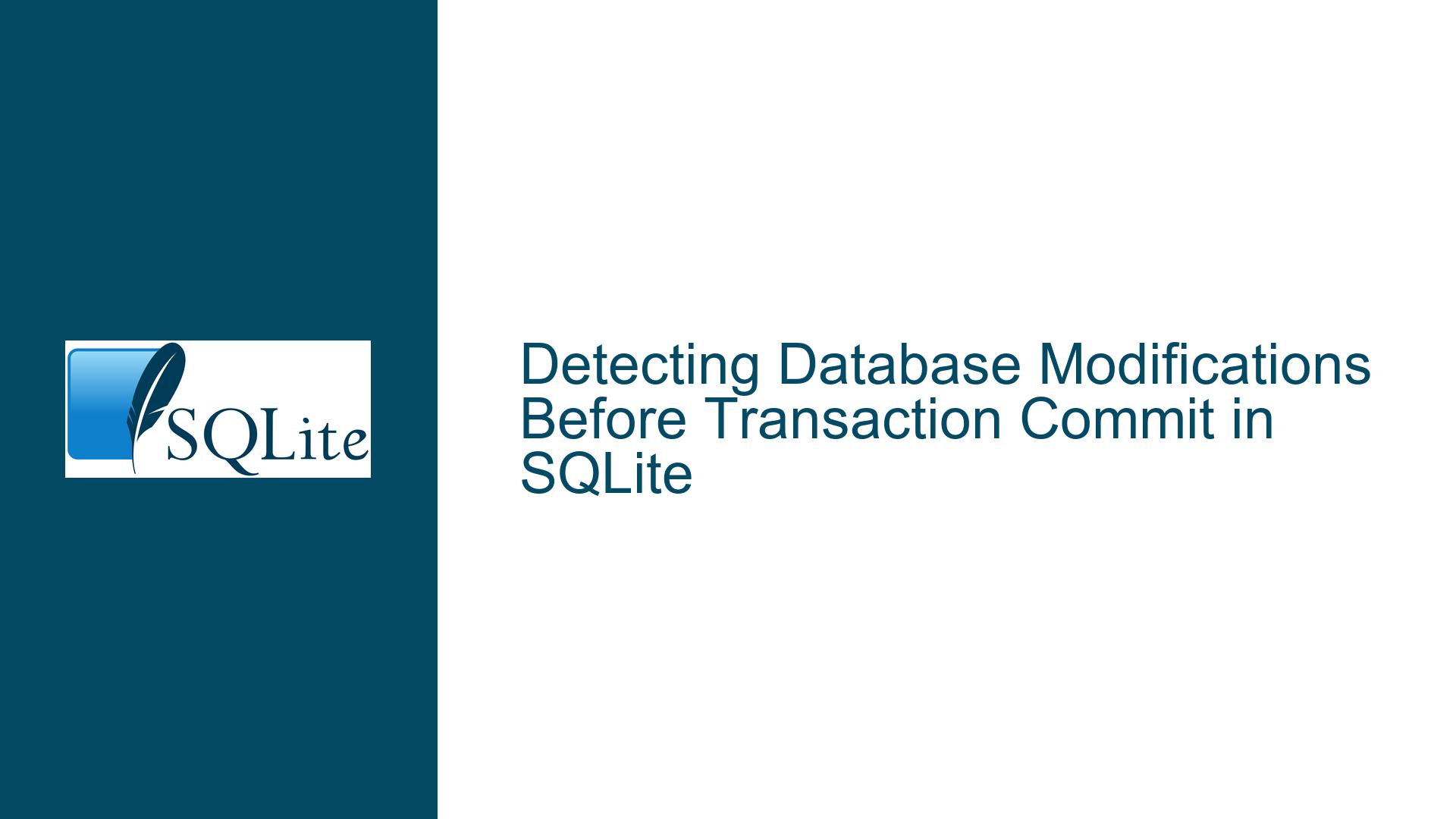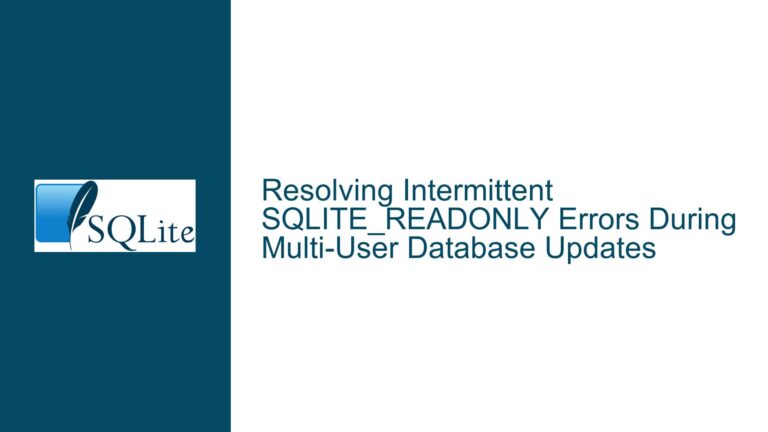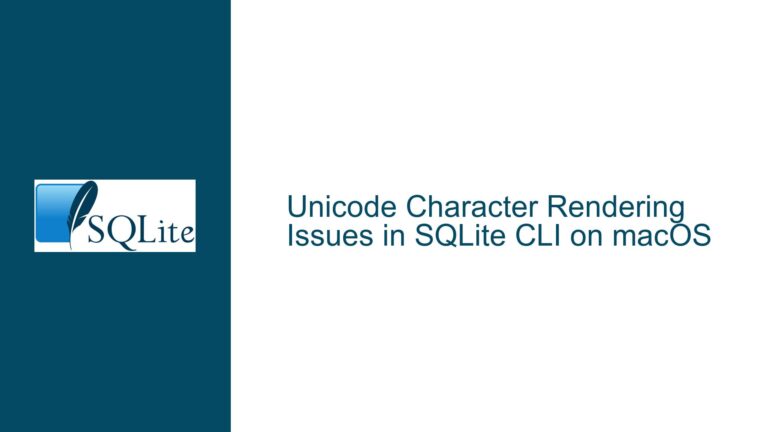Detecting Database Modifications Before Transaction Commit in SQLite
SQLite Transaction Commit Behavior and Modification Detection
Understanding the behavior of SQLite transactions and the ability to detect modifications before committing is crucial for developers who need to ensure data integrity and optimize their database operations. SQLite, being a lightweight, serverless database engine, provides several mechanisms to track changes, but these mechanisms often come with limitations that can lead to confusion or inefficiencies if not properly understood.
When a transaction is initiated in SQLite, all subsequent operations within that transaction are temporarily held in memory until the transaction is either committed or rolled back. This means that any INSERT, UPDATE, DELETE, or other data-modifying operations do not immediately affect the database file on disk. Instead, these changes are only written to the database file upon a successful commit. This behavior is fundamental to SQLite’s transactional integrity but poses a challenge for developers who need to determine whether a transaction will result in actual changes to the database before committing.
The sqlite3_total_changes function is often used to track the number of rows that have been modified by INSERT, UPDATE, or DELETE operations. However, this function has a significant limitation: it only accounts for these three types of operations. Other SQL operations that can modify the database, such as ALTER TABLE, CREATE INDEX, or PRAGMA statements, are not tracked by sqlite3_total_changes. This limitation can lead to scenarios where a transaction appears to have no modifications based on sqlite3_total_changes, but in reality, it includes operations that will alter the database schema or other critical aspects.
Another approach to detecting modifications is the use of the SQLITE_FCNTL_DATA_VERSION control, which provides a version number that increments with each change to the database. However, this control is only effective after a transaction has been committed, making it unsuitable for detecting changes before the commit. This leaves developers in a predicament when they need to make decisions based on whether a transaction will modify the database, especially in scenarios where additional queries or operations depend on the outcome of the current transaction.
The sqlite3_txn_state function emerges as a potential solution to this problem. This function allows developers to determine the current state of a transaction, including whether it is in a read or write state. By using sqlite3_txn_state, developers can infer whether a transaction has the potential to modify the database. However, this function does not provide a direct indication of whether the transaction will result in actual changes to the database file. Instead, it serves as a tool to understand the transactional context, which can be combined with other techniques to achieve the desired outcome.
In summary, detecting whether a transaction will modify the database before committing is a nuanced challenge in SQLite. While functions like sqlite3_total_changes and SQLITE_FCNTL_DATA_VERSION offer partial solutions, they are not comprehensive. The sqlite3_txn_state function provides additional context but does not directly solve the problem. Developers must carefully consider the limitations of these tools and explore alternative strategies to achieve reliable detection of database modifications before committing a transaction.
Limitations of sqlite3_total_changes and SQLITE_FCNTL_DATA_VERSION
The sqlite3_total_changes function and the SQLITE_FCNTL_DATA_VERSION control are two commonly used mechanisms in SQLite for tracking database modifications. However, both have significant limitations that can hinder their effectiveness in certain scenarios, particularly when trying to detect modifications before committing a transaction.
The sqlite3_total_changes function returns the total number of rows that have been inserted, updated, or deleted since the database connection was opened. While this function is useful for tracking changes resulting from these specific operations, it does not account for other types of SQL operations that can modify the database. For example, operations such as ALTER TABLE, CREATE INDEX, DROP TABLE, and PRAGMA statements can all result in changes to the database schema or other critical aspects, but these changes are not reflected in the count returned by sqlite3_total_changes. This limitation can lead to misleading results, as a transaction that includes such operations may appear to have no modifications based on sqlite3_total_changes, even though it will result in significant changes to the database.
Another limitation of sqlite3_total_changes is that it does not distinguish between changes that are part of the current transaction and changes that have already been committed. This means that even if a transaction includes operations that modify the database, the count returned by sqlite3_total_changes may not increase until the transaction is committed. This behavior can make it difficult to determine whether the current transaction will result in modifications to the database before committing.
The SQLITE_FCNTL_DATA_VERSION control, on the other hand, provides a version number that increments with each change to the database. This control can be used to detect changes to the database at a high level, but it has a critical limitation: it only reflects changes after they have been committed. This means that SQLITE_FCNTL_DATA_VERSION cannot be used to detect modifications that are part of an uncommitted transaction. As a result, this control is not suitable for scenarios where developers need to determine whether a transaction will modify the database before committing.
In addition to these limitations, both sqlite3_total_changes and SQLITE_FCNTL_DATA_VERSION are affected by the transactional context in which they are used. For example, if a transaction is rolled back, any changes that were part of that transaction will not be reflected in the count returned by sqlite3_total_changes or the version number provided by SQLITE_FCNTL_DATA_VERSION. This behavior can further complicate the task of detecting modifications before committing a transaction, as developers must account for the possibility that changes may be rolled back and therefore not reflected in these metrics.
In summary, while sqlite3_total_changes and SQLITE_FCNTL_DATA_VERSION provide useful mechanisms for tracking database modifications, they have significant limitations that can hinder their effectiveness in certain scenarios. Developers must be aware of these limitations and consider alternative approaches when trying to detect modifications before committing a transaction.
Leveraging sqlite3_txn_state for Transaction State Detection
The sqlite3_txn_state function offers a more nuanced approach to understanding the state of a transaction in SQLite, providing developers with valuable context that can be used to infer whether a transaction has the potential to modify the database. This function returns the current state of a transaction, which can be one of the following: SQLITE_TXN_NONE, SQLITE_TXN_READ, or SQLITE_TXN_WRITE. By examining the transaction state, developers can gain insights into whether a transaction is in a read-only or read-write state, which can help them determine whether the transaction is likely to result in modifications to the database.
When a transaction is in the SQLITE_TXN_NONE state, it means that no transaction is currently active. This state is typically observed when no transaction has been started, or when a transaction has been committed or rolled back. In this state, any operations performed on the database will be executed outside of a transactional context, meaning that changes will be immediately written to the database file.
The SQLITE_TXN_READ state indicates that a read-only transaction is active. In this state, the transaction can perform read operations on the database, but it cannot perform any operations that would modify the database. This state is useful for scenarios where a transaction needs to ensure that the data being read remains consistent throughout the transaction, but it does not provide any information about whether the transaction will result in modifications to the database.
The SQLITE_TXN_WRITE state, on the other hand, indicates that a read-write transaction is active. In this state, the transaction can perform both read and write operations on the database. This state is significant because it indicates that the transaction has the potential to modify the database. However, it is important to note that being in the SQLITE_TXN_WRITE state does not guarantee that the transaction will result in modifications to the database. It simply means that the transaction has the capability to perform write operations.
By using sqlite3_txn_state, developers can determine whether a transaction is in a state that allows for write operations, which can help them infer whether the transaction is likely to result in modifications to the database. However, this function does not provide a direct indication of whether the transaction will actually modify the database. Instead, it provides context that can be used in combination with other techniques to achieve the desired outcome.
For example, developers can use sqlite3_txn_state to check whether a transaction is in the SQLITE_TXN_WRITE state before performing additional operations that depend on whether the transaction will modify the database. If the transaction is in the SQLITE_TXN_WRITE state, developers can then use other mechanisms, such as sqlite3_total_changes, to track the number of rows that have been modified by INSERT, UPDATE, or DELETE operations. While this approach does not account for other types of SQL operations that can modify the database, it provides a more comprehensive solution than relying on sqlite3_total_changes alone.
In summary, the sqlite3_txn_state function provides valuable context about the state of a transaction, which can be used to infer whether the transaction has the potential to modify the database. While this function does not directly solve the problem of detecting modifications before committing a transaction, it offers a useful tool that can be combined with other techniques to achieve a more reliable solution. Developers should consider using sqlite3_txn_state in conjunction with other mechanisms to gain a more complete understanding of whether a transaction will result in modifications to the database.






